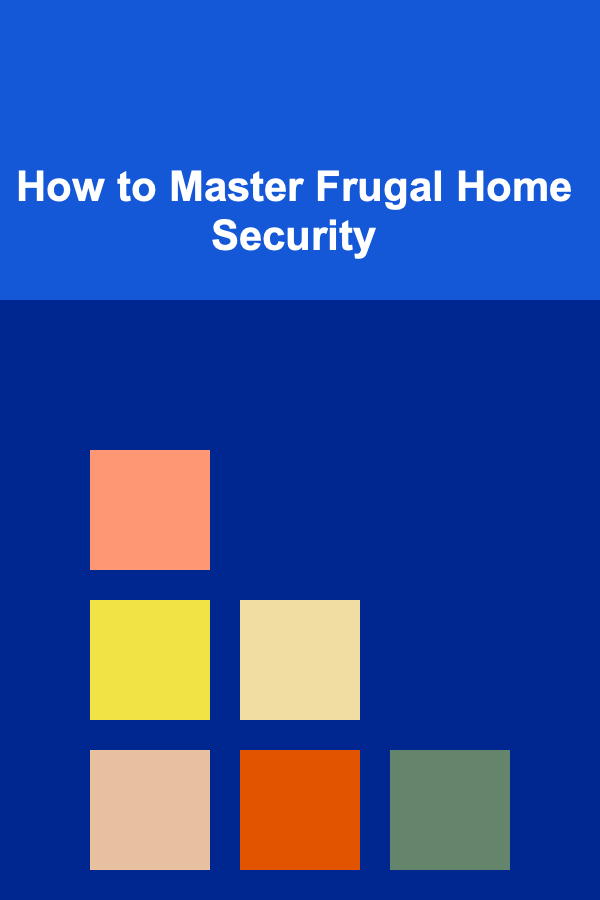
How to Master Frugal Home Security
ebook include PDF & Audio bundle (Micro Guide)
$12.99$6.99
Limited Time Offer! Order within the next:

When it comes to protecting your home, security is a priority. Many homeowners fear that achieving a secure environment requires spending a small fortune on elaborate systems or high-tech gadgets. However, this isn't the case. In fact, mastering frugal home security is entirely possible without compromising on safety or effectiveness. The key lies in smart choices, prioritizing essential security measures, and leveraging available resources to their fullest potential. This article will explore practical, cost-effective ways to improve your home security while remaining budget-conscious.
Understanding the Basics of Home Security
Before diving into specific strategies, it's important to first understand what home security encompasses. At its core, home security is about minimizing the risk of break-ins, theft, and other threats to your property and loved ones. While there are many advanced systems available today, effective security doesn't always require expensive tools. Basic elements of home security include:
- Physical barriers: Locks, doors, windows, and fences.
- Detection systems: Alarms, cameras, and motion detectors.
- Monitoring: Awareness of surroundings, neighborhood watch, and self-surveillance.
By mastering these basic concepts, you can design a robust yet affordable security plan for your home.
Start with the Basics: Strengthening Entry Points
One of the most vulnerable areas of any home is its entry points. Burglars often look for easy access through doors, windows, and even the garage. Strengthening these areas is an effective and low-cost way to improve security.
2.1. Doors and Locks
The first and most obvious step is to ensure that your doors are strong and well-secured. Solid wood or metal doors provide a higher level of security than hollow-core doors. Additionally, focus on the type of locks you use. Deadbolt locks are one of the most secure locking mechanisms available and are relatively inexpensive.
If you want to further improve door security without breaking the bank, consider adding a door reinforcement plate. This is a metal plate that strengthens the door frame, preventing burglars from easily kicking it in. These plates are affordable and easy to install with minimal tools.
2.2. Windows and Glass Doors
Windows are another weak point for many homes. Consider installing window locks or security bars on easily accessible windows. These can be especially beneficial for basement or ground-floor windows. For sliding glass doors, add a rod or security bar in the track to prevent them from being forced open.
Furthermore, adding a simple window film or shatterproof glass coating can make it harder for intruders to break the glass. While this may seem like a small detail, it can slow down burglars and give you or your neighbors more time to react.
Surveillance on a Budget: DIY Cameras and Monitoring
High-end home surveillance systems can be expensive, but that doesn't mean you have to forgo monitoring. With today's technology, you can create an effective surveillance system on a shoestring budget.
3.1. Smartphone Surveillance
One of the simplest and most cost-effective ways to monitor your home is by using smartphones and old security cameras. There are several apps available that allow you to turn old smartphones into security cameras. Apps such as Alfred or Manything allow you to set up one phone to monitor an area and another device to view the live feed. This method doesn't require a significant investment in new hardware.
3.2. Budget-Friendly Security Cameras
If you're willing to spend a little more money, there are several affordable home security cameras available. Look for options that offer basic features such as motion detection, night vision, and remote access via an app. Popular brands like Wyze and Blink offer cameras at a fraction of the price of traditional home security systems. These cameras can be easily installed without professional help and can provide valuable peace of mind.
3.3. Motion-Activated Lighting
Motion-activated lights can significantly improve security around the exterior of your home. These lights deter burglars who rely on darkness to remain undetected. Installing motion-sensing lights near doorways, pathways, and garages can create an illusion of constant surveillance and reduce the chances of a break-in.
What's great about motion-activated lights is that they don't have to be expensive. You can find a variety of affordable, battery-operated motion-sensor lights at home improvement stores or online. Additionally, these lights often have a wide coverage area, which maximizes their effectiveness.
Use Technology for Monitoring Without Paying for a Service
Monitoring is often the most expensive aspect of home security systems, especially when it involves paying for monthly subscriptions. Fortunately, there are ways to monitor your home without the recurring costs of a professional service.
4.1. DIY Alarm Systems
You can create your own alarm system for a fraction of the cost of professional monitoring. Budget-friendly options include motion detectors, door/window sensors, and sound-based alarms. Many of these devices are wireless, easy to install, and can be integrated with smartphones for remote alerts.
Brands like SimpliSafe and Ring offer affordable systems that allow you to monitor your home through your phone. While they may have monthly plans, these are generally optional, and many users find that a simple DIY alarm system can provide the security they need without the additional cost.
4.2. Neighborhood Watch and Community Involvement
Building a strong relationship with your neighbors is one of the best ways to secure your home for little to no cost. If you don't have a formal neighborhood watch program, consider starting one or joining an existing group. Neighbors who look out for each other and communicate about suspicious activity can be an effective deterrent against criminal behavior.
Additionally, staying active in your community means that you are more likely to hear about local threats, such as burglaries or break-ins. Having an informed, vigilant neighborhood can provide you with extra security and peace of mind.
Frugal Home Security Practices
While hardware and technology are crucial, many aspects of home security involve simple, everyday practices that can enhance your protection without spending a lot of money. The way you behave and manage your property can make a big difference.
5.1. Keep Your Property Well-Maintained
A well-maintained property signals to potential intruders that the home is likely well-protected. Overgrown shrubs, tall trees, and poorly lit entryways can provide cover for criminals, making it easier for them to enter unnoticed. Trim bushes, cut back trees, and install lights to reduce hiding spots around your property.
Furthermore, ensure that your fences, gates, and entryways are secure and free from gaps or weaknesses. Repairing small issues like a broken fence or malfunctioning gate lock can be done affordably and can improve your home's overall security.
5.2. Practice Smart Social Media Habits
One modern security risk is oversharing on social media. Many burglars check social media platforms to find out when people are away from home. Avoid posting vacation plans, pictures, or any other information that could tip off criminals about when your home will be unoccupied.
Similarly, consider using a vacation hold on your mail or newspapers to prevent them from piling up on your porch, which can indicate that no one is home. You can also ask a trusted neighbor to collect your mail while you're away.
5.3. Always Lock Your Doors and Windows
It might seem simple, but many break-ins happen because a door or window is left unlocked. Make it a habit to lock all doors and windows, even when you are at home. Additionally, make sure that spare keys aren't left under the doormat or in obvious places. Use a lockbox or give the spare key to a trusted neighbor or friend.
Consider Long-Term Investments in Security
While it's important to focus on short-term, budget-friendly solutions, there are also long-term investments that will improve your home's security over time. These investments are worth considering if you want to provide a higher level of protection in the future.
6.1. Security System with Professional Monitoring
If you are looking for a more comprehensive solution, consider investing in a security system with professional monitoring. While these systems come with higher initial costs, they can offer 24/7 monitoring and additional peace of mind. Many systems offer affordable monthly plans, and some even provide equipment at no upfront cost if you commit to a contract.
6.2. High-Security Doors and Windows
Investing in high-security doors and windows may be a larger financial commitment, but they can provide long-term value and security. Look for doors with reinforced steel or solid wood construction, as well as windows made from impact-resistant glass.
While these upgrades can be more expensive upfront, they can significantly increase the safety of your home and may even result in lower insurance premiums over time.
Conclusion
Mastering frugal home security is all about being smart, resourceful, and vigilant. By focusing on affordable yet effective solutions, you can significantly enhance the safety of your home without breaking the bank. Strengthening entry points, using technology creatively, monitoring your property, and practicing simple, smart habits can make a huge difference in protecting your home.
Ultimately, home security is about more than just expensive gadgets or complex systems. With careful planning, a few low-cost investments, and a commitment to smart practices, anyone can achieve a secure home on a budget.

Creativity: Techniques for Unlocking Your Creative Potential
Read More
How to Implement Website Security: A Checklist for Protecting Your Site
Read More
How to Maintain the Condition of Luxury Leather Goods
Read More
How to Soundproof Your Home with DIY Acoustic Treatments
Read More
Practical Strategies for Reducing Medical Expenses and Managing Healthcare Costs
Read More
Understanding Stereolithography (SLA) 3D Printing: A Comprehensive Guide
Read MoreOther Products

Creativity: Techniques for Unlocking Your Creative Potential
Read More
How to Implement Website Security: A Checklist for Protecting Your Site
Read More
How to Maintain the Condition of Luxury Leather Goods
Read More
How to Soundproof Your Home with DIY Acoustic Treatments
Read More
Practical Strategies for Reducing Medical Expenses and Managing Healthcare Costs
Read More